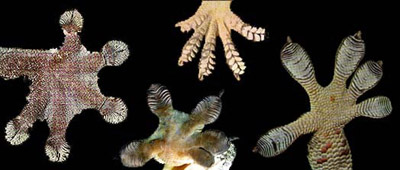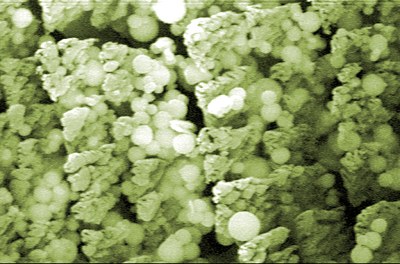Geckos are well known for their ability to cling to almost any surface and at any angle. They can hang upside down from polished glass by a single toe, putting even Spiderman to shame! Scientists only recently worked out how the microscopic adhesive hairs – or setae – that cover the animals’ feet work; it turns out van der Waals’ forces help them climb walls.
Now, the US team who made that discovery have found that the gecko’s adhesive is not only strong, but self cleaning. The very sticky feet of the gecko have a built-in cleaning mechanism that clears off dirt in just a few steps, according to Wendy Hansen and Kellar Autumn of the Lewis and Clark College in Portland, Oregon.

Gecko feet
Gecko toes carry millions of microscopic setae, which like a million tiny pads allow it to stick to most surfaces, rough or smooth. But, biologists could not explain how geckos keep their sticky setae clean as the animal does not actively groom its feet as one might expect. Moreover, the feet do not secrete any specialist cleaning fluid to slough off dust and debris.
Hansen and Autumn were inspired to check out the setae in detail to see if they could work out how the gecko keeps its feet so pristine. The team dipped the feet of live geckos in harmless silica microspheres and measured the forces of adhesion in the toes before and after simulated steps on clean glass. Amazingly, the gecko’s feet become clean and free of silica microspheres within a few steps.

The tokay gecko (Gekko gecko) climbing up a sheet of glass leaves microsphere footprints behind it illuminated by laser light. (Copyright 2004: Kellar, Autumn, Lewis & Clark College)
The team could also then test the setae by themselves to see if they self-clean. Fortunately we can remove patches of setae without harming the gecko since the animals shed and re-grow their skin every two months, Autumn told Spotlight, The measurement of self-cleaning in isolated gecko setae was the most important part of our experiment. Compare this with a piece of adhesive tape, which just gets dirtier and dirtier with re-use. The research demonstrates that setae are intrinsically self-cleaning, and could therefore be replicated in a synthetic material, adds Autumn.

Setae with attached particles
The team found that the self-cleaning effect is simply a result of the attraction for dirt (the silica particles) being slightly less than for the surface on which the animal is walking. This results in a net cleaning effect. Such research may seem far removed from any technological application, but already researchers are simulating gecko setae to make novel removable adhesives. Hansen and Autumn now hope to apply their work to engineering self-cleaning adhesives.

Kellar Autumn
Our mathematical models suggest that self-cleaning in gecko setae is a result of geometry not chemistry, explains Autumn, This means that synthetic self-cleaning adhesives could be fabricated from a wide variety of materials. He and his colleagues envisage numerous applications for an artificial version of the gecko self-cleaning adhesive. We envision uses for our discovery ranging from nanosurgery to aerospace applications, he adds, Who knows – maybe a gecko-inspired robot with sticky feet will walk on the dusty surface of Mars someday.

Wendy Hansen in 2001
Further reading
Proc Natl Acad Sci, 2005, in press
http://dx.doi.org/10.1073/pnas.0408304102
Autumn Lab Homepage
http://www.lclark.edu/~autumn/dept/Welcome.html
Wendy Hansen Wins Rena Ratte Award
http://www.lclark.edu/dept/public/wendyhansen.html
Suggested searches
van der Waals